Disclosure: This post may contain affiliate links. I may earn a small commission for my endorsement, recommendation, testimonial, and/or link to any products or services from this website.
Gochujang Pasta combines al dente pasta noodles with a bold and fiery gochujang sauce, giving you a flavor-packed meal that will make your tastebuds dance. Vegan, Gluten-Free Option.
This Gochujang Pasta Recipe combines Italian and Korean flavors for a hearty, fiery, and satisfying recipe. Featuring pasta noodles tossed in an easy gochujang sauce, this meal is bold, addictively delicious, and a fun way to take pasta night to a totally different level.
Table of Contents
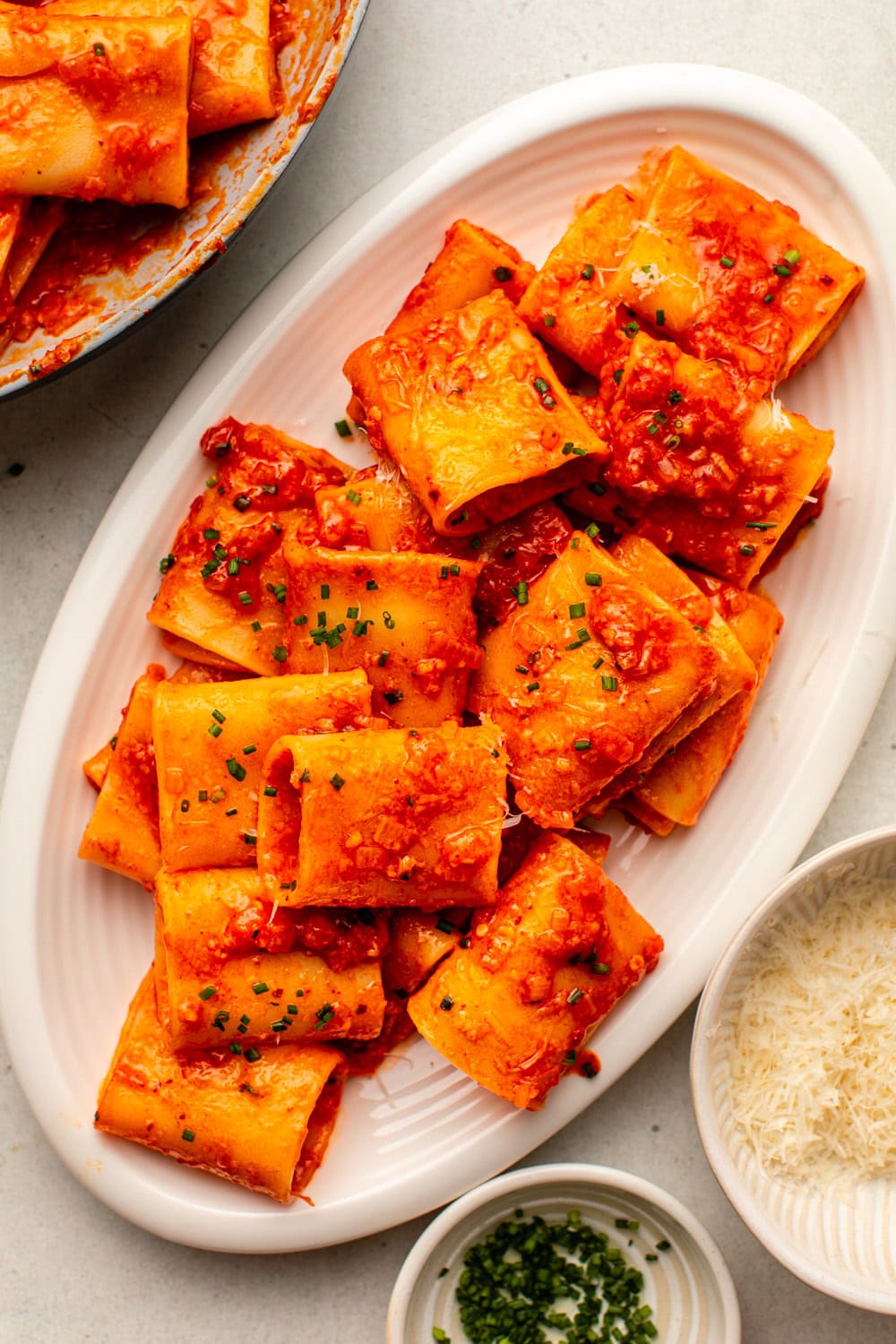
All About Gochujang Pasta
Gochujang (고추장) is a staple in Korean cooking and just happens to be one of my favorite condiments. I’ve used it before in this Korean-inspired Vegan Tteokbokki and this Saucy Gochujang Tofu; the Korean fermented spicy and sweet pepper paste gives big and bold flavors I (or anyone I’m serving) can’t get enough of.
So, it’s no surprise that I’m practically obsessed with this Vegan Gochujang Pasta. The Korean-inspired gochujang pasta sauce in this Italian-Korean fusion dish is a flavor-packed spin on classic tomato sauce, coating each noodle with its crimson red, slightly sweet-savory goodness. It’s a game-changer for pasta night!
Ingredients for Gochujang Pasta
You need some basic ingredients, plus a few Korean pantry staples, to make this Korean-inspired pasta dinner:
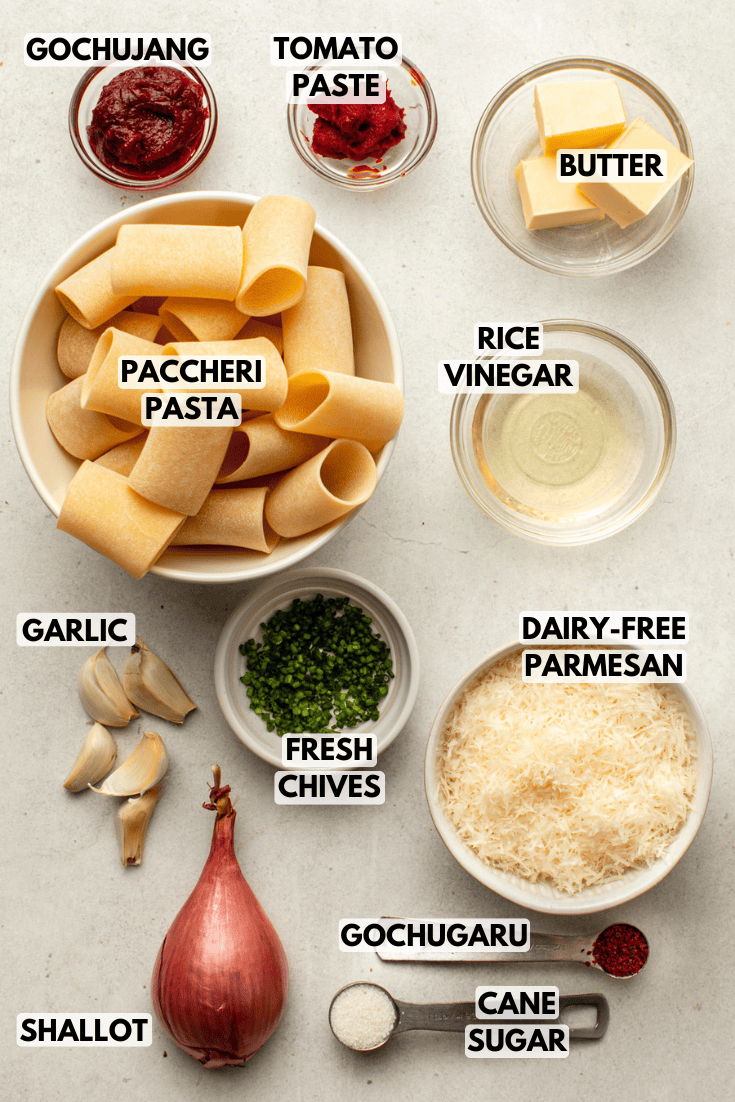
- Gochujang: Gochujang is a fermented Korean pepper paste with sweet, savory, and spicy flavors. Because its popularity has taken off in recent years, you shouldn’t have trouble finding gochujang in the Asian or international aisle of your local grocery store (I’ve always been able to find it at Trader Joe’s or my local Asian market). I use and recommend Chung Jung One O’Food Gochujang.
- Pasta: While any kind of pasta noodle will do here, large ridged, tubular pasta noodles trap the sauce really well and make for a dramatic presentation! I like making this dish with rigatoni or Paccheri No. 125 pasta.
- Gochugaru: This is like Korean chili powder and adds extra heat to the pasta sauce. I buy this brand from my local Asian market or online.
- Rice wine vinegar: Just a splash adds a bright tanginess that helps balance the stronger flavors in the gochujang pasta sauce.
- Shallot and garlic: These two aromatics are cooked down until they’re nice and jammy to give the pasta sauce a savory baseline of flavor.
How to Make Gochujang Pasta
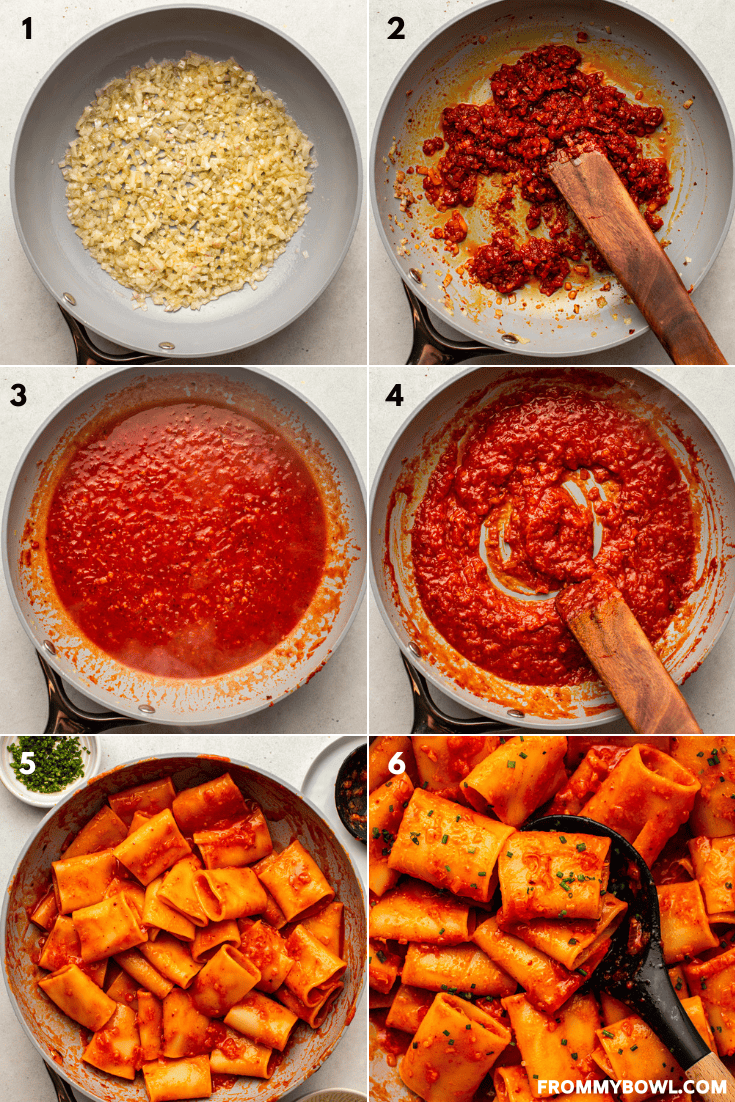
- Boil the pasta until al dente. Reserve 1 cup of the pasta cooking water, then drain the pasta and set it aside.
- Stir the rice vinegar and cane sugar together in a small bowl until the sugar is dissolved.
- Melt the vegan butter in a large saucepan over medium heat. Sauté the shallot and garlic in the pan until golden and fragrant.
- Add the gochujang, tomato paste, and gochugaru to the pan. Stir frequently for 1 minute, then deglaze the pan with the rice vinegar mixture. Pour half of the reserved pasta water into the pan. Let it simmer until you have a smooth and slightly thick sauce.
- Add the remaining butter, vegan parmesan, and drained pasta. Toss to coat.
- Serve the pasta in bowls and garnish with chopped chives and extra parmesan.
Caitlin’s Cooking Tips
- Reserve some of the pasta cooking water: This starchy liquid gold is the key to a silky smooth gochujang pasta sauce!
- Cook the gochujang paste: According to Bon Appetit, the secret to unlocking tomato paste’s wonderful hidden flavors is by letting it sizzle in a hot pan until it caramelizes. Gochujang is like a more flavorful tomato paste, and by cooking it for about 1 minute before deglazing the hot pan, you can take its layers of flavors to a whole new level.
- How to tell the sauce is ready: Drag a spatula or wooden spoon along the bottom of the pan after simmering the reserved pasta water in the sauce for 3 to 5 minutes (step 4 in the recipe directions). If a clear line is left behind, the sauce is cooked perfectly and is ready for the pasta.
- If the sauce is too thick: Thin the consistency by stirring in 2 tablespoons of reserved pasta water at a time until it reaches your desired consistency.

Serving Suggestions
Chances are this gochujang pasta is going to feel fiery in your mouth, so pair it with a few refreshing and cooling side dishes. It would pair nicely with this Smashed Cucumber Salad with Edamame and this Crunchy Ginger Cabbage Slaw. Crusty slices of bread on the side are always welcome, too.
If you’re looking for more delicious pasta recipes, you’ll also love this Roasted Red Pepper Pasta, this Beet Pasta with Walnuts, and this Easy One-Pot Pasta!
How to Store Gochujang Pasta
The leftover pasta will keep in the fridge for up to 5 days. Let the pasta cool to room temperature before transferring it to an airtight container.
Leftovers reheat well in the microwave or in a saucepan over medium heat. Add a splash of water or vegetable broth to the pan to make the consistency nice and saucy again.
Substitutions and Variations
- Gluten-Free Option: Remember that gochujang is typically made with wheat, so you’ll need to use wheat-free gochujang to make this recipe gluten-free. Use your favorite gluten-free pasta as well.
- Gochugaru Substitute: If you can’t find gochugaru, use equal parts crushed red pepper instead.
- Creamy Option: A splash of canned coconut milk, cashew cream, or a thick and fatty non-dairy milk (like soy or oat milk) in the sauce will transform this into a creamy gochujang pasta. Add the “cream” when you add the remaining butter and parmesan cheese.
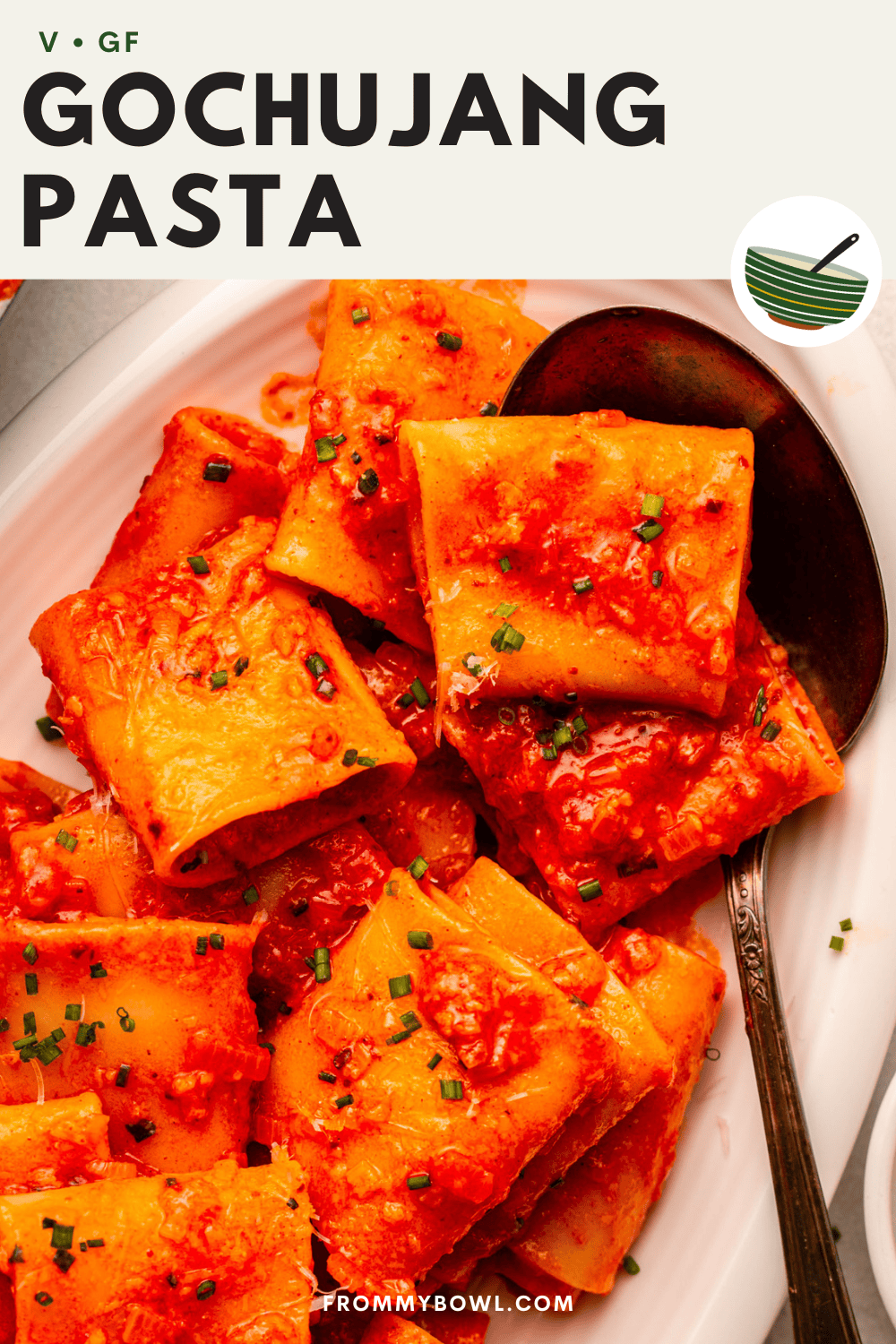
Recipe FAQs
Yes, gochujang is a red chili paste made entirely from plants! Just remember that it isn’t always gluten-free, so check the nutritional information on the label for wheat before purchasing.
I don’t love the idea of substituting gochujang for anything else because it gives the pasta its signature intense punch of flavor. However, if you can’t find gochujang, you can use an equal amount of sriracha or another red chili paste or sauce instead.
Feel free to stir steamed or sautéed vegetables into the pasta at the end, like shredded cabbage, sliced mushrooms, baby spinach leaves, bok choy, or green onions.
Enjoy! If you make this recipe and decide to share it on Facebook or Instagram, don’t forget to tag me @FromMyBowl + #FromMyBowl! I would also love it if you could leave a comment below with a recipe rating! Thank you for the support 😊
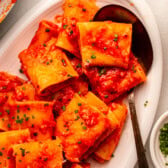
Gochujang Pasta
Ingredients
- 8 ounces rigatoni or paccheri pasta I used Paccheri No. 125
- Kosher salt to taste
- 2 tablespoons unseasoned rice wine vinegar
- 1 teaspoon cane sugar
- 3 tablespoons butter divided
- 1 shallot fine dice
- 5 cloves garlic minced
- 2 tablespoons gochujang*
- 1 tablespoon tomato paste
- 1/2 teaspoon gochugaru* optional, omit for less heat
- 1/2 ounce finely grated parmesan I used dairy-free
- Fresh chives chopped; for garnish (or sub green onion)
Instructions
- Cook the Pasta: Bring a large pot of salted water to a boil and add the pasta. Cook until al dente, reserving 1 cup of the pasta water while the pasta is boiling. Drain and set aside.
- Prep: In the meantime, combine the rice vinegar and cane sugar together in a small bowl. Mix well, until the sugar is dissolved. Set aside.
- Aromatics: Melt 2 tablespoons of butter in a large saucepan over medium heat. Add the shallot and sauté for 3 to 5 minutes, until translucent and golden. Add the garlic and sauté for 1 minute.
- Make the Sauce: Add the gochujang, tomato paste, and gochugaru (if using) to the aromatics, using a spatula to break up the paste so it is evenly distributed. Sauté for 1 minute, stirring frequently. Deglaze the pan with the rice vinegar mixture and mix well. Once the liquid from the vinegar has evaporated, add in 1/2 cup of the reserved pasta water. Bring to a simmer, stirring occasionally, and cook down for 3 to 5 minutes, or until you can drag a spatula through the sauce and leave a clear line.
- Combine: Reduce the heat to low and add in the remaining butter, parmesan, and drained pasta. Mix well, until the cheese has melted and a thick sauce forms. If the sauce is too thick, thin it out with ~2 tablespoon increments of reserved pasta water until it reaches your desired consistency.
- Serve: Transfer the pasta to a serving dish and top with finely chopped chives and extra parmesan, if desired. Serve warm; leftovers can be stored in the refrigerator for up to 5 days.
Recipe Notes
- Gochujang: Gochujang is a Korean fermented pepper paste that is sweet, savory, and spicy. I use and recommend this brand. You may be able to find it in the Asian or International aisle of your grocery store, or you can also find it at Trader Joe’s or your local Asian market. Gochujang is typically made with wheat, but you can also purchase wheat-free gochujang (see below).
- Gochugaru: Gochugaru is a ground Korean chili pepper and adds extra heat to this recipe. I usually purchase mine at my local Asian market or online; if you do not have any, you can substitute it with equal parts crushed red pepper.
- Gluten-Free: Use gluten-free pasta and gluten-free gochujang to make this recipe gluten-free.
- Butter can be substituted with olive oil, if desired.
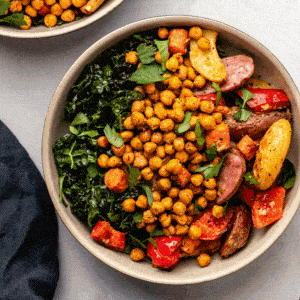
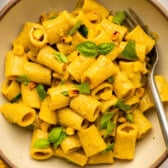


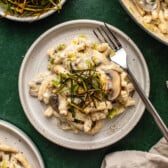
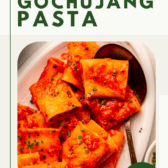
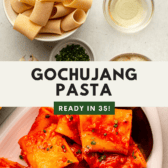
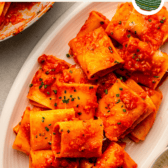
This is so good!!!!!
Happy you enjoyed it, Kendra!